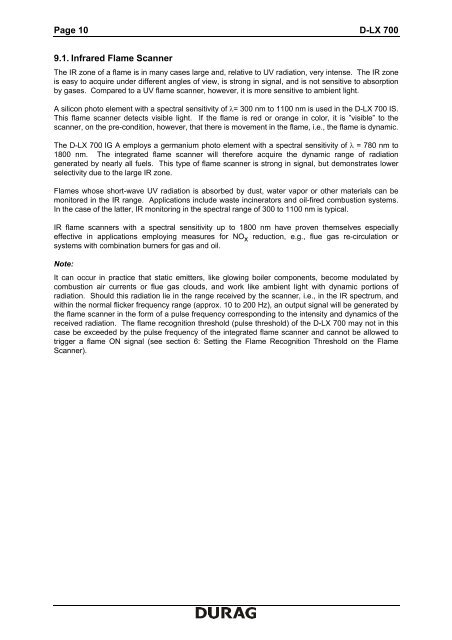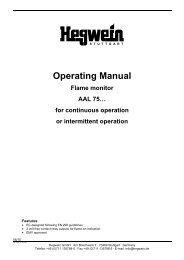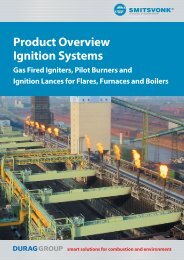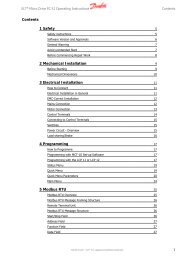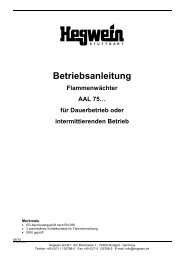Create successful ePaper yourself
Turn your PDF publications into a flip-book with our unique Google optimized e-Paper software.
Page 10 D-<strong>LX</strong> <strong>700</strong><br />
9.1. Infrared Flame Scanner<br />
The IR zone of a flame is in many cases large and, relative to UV radiation, very int<strong>en</strong>se. The IR zone<br />
is easy to acquire under differ<strong>en</strong>t angles of view, is strong in signal, and is not s<strong>en</strong>sitive to absorption<br />
by gases. Compared to a UV flame scanner, however, it is more s<strong>en</strong>sitive to ambi<strong>en</strong>t light.<br />
A silicon photo elem<strong>en</strong>t with a spectral s<strong>en</strong>sitivity of λ= 300 nm to 1100 nm is used in the D-<strong>LX</strong> <strong>700</strong> IS.<br />
This flame scanner detects visible light. If the flame is red or orange in color, it is ”visible” to the<br />
scanner, on the pre-condition, however, that there is movem<strong>en</strong>t in the flame, i.e., the flame is dynamic.<br />
The D-<strong>LX</strong> <strong>700</strong> IG A employs a germanium photo elem<strong>en</strong>t with a spectral s<strong>en</strong>sitivity of λ = 780 nm to<br />
1800 nm. The integrated flame scanner will therefore acquire the dynamic range of radiation<br />
g<strong>en</strong>erated by nearly all fuels. This type of flame scanner is strong in signal, but demonstrates lower<br />
selectivity due to the large IR zone.<br />
Flames whose short-wave UV radiation is absorbed by dust, water vapor or other materials can be<br />
monitored in the IR range. Applications include waste incinerators and oil-fired combustion systems.<br />
In the case of the latter, IR monitoring in the spectral range of 300 to 1100 nm is typical.<br />
IR flame scanners with a spectral s<strong>en</strong>sitivity up to 1800 nm have prov<strong>en</strong> themselves especially<br />
effective in applications employing measures for NO x reduction, e.g., flue gas re-circulation or<br />
systems with combination burners for gas and oil.<br />
Note:<br />
It can occur in practice that static emitters, like glowing boiler compon<strong>en</strong>ts, become modulated by<br />
combustion air curr<strong>en</strong>ts or flue gas clouds, and work like ambi<strong>en</strong>t light with dynamic portions of<br />
radiation. Should this radiation lie in the range received by the scanner, i.e., in the IR spectrum, and<br />
within the normal flicker frequ<strong>en</strong>cy range (approx. 10 to 200 Hz), an output signal will be g<strong>en</strong>erated by<br />
the flame scanner in the form of a pulse frequ<strong>en</strong>cy corresponding to the int<strong>en</strong>sity and dynamics of the<br />
received radiation. The flame recognition threshold (pulse threshold) of the D-<strong>LX</strong> <strong>700</strong> may not in this<br />
case be exceeded by the pulse frequ<strong>en</strong>cy of the integrated flame scanner and cannot be allowed to<br />
trigger a flame ON signal (see section 6: Setting the Flame Recognition Threshold on the Flame<br />
Scanner).


